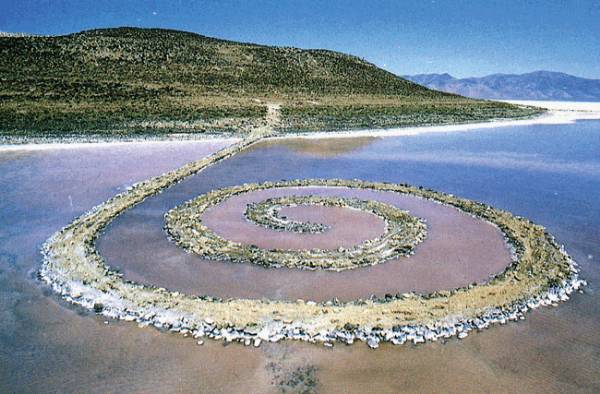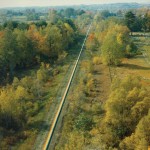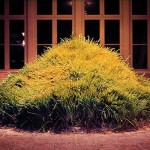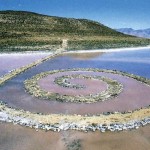Subscribe to Our Newsletter
Land Art: Earthworks that Defined Postwar American Art

In the Sixties, art left the galleries and museums and went back to the land. Four decades later, Land Art is coming indoors.

Robert Smithson, Spiral Jetty, 1970
This article originally appeared in the April issue of Art & Antiques Magazine as “Uncommon Ground”.
By Dana Micucci
- Patricia Johanson, Stephen Long, 1968
- Hans Haacke, Grass Grows, 1967-69
- Robert Smithson, Spiral Jetty, 1970
It was 1968, and the U.S. was in the midst of a revolution. Civil-rights marches, the women’s liberation movement and anti-war protests were raging. Environmental activism was on the rise. The first man would soon walk on the moon. And the Virginia Dwan Gallery in New York City mounted a radical new exhibition called “Earthworks,” featuring artists such as Robert Smithson, Walter de Maria and Michael Heizer. Taking vast, remote landscapes and the ephemeral conditions of nature as their sculptural canvas, these and other artists staged their own protest by rejecting traditional sculptural forms and practices, rigid modernist theory and the commercial confines of the museum-and-gallery system to create frequently massive land art works that heightened awareness of our relationship with the earth and challenged accepted definitions of art.
Made of natural materials including rock, soil, sand and water—sometimes combined with industrial materials such as concrete, metal and asphalt—many of the early earth works from the late 1960s to early ’70s sprang up in the open deserts of the American West. These bold new experiments played with light and space, perception and the passage of time. They charted an arresting intersection between the temporal and divine, often recalling ancient monumental land works such as Stonehenge, the Pyramids, Native American mounds and the Nazca Lines in Peru. Yet they also drew from minimal and conceptual art, such as Italian Arte Povera, which exalted crude, humble materials, and the social sculpture of the German avant-garde artist Joseph Beuys. Subject to the shifting whims of nature, some of these works were short-lived, preserved only in photographs, drawings, video and film, ironically subverting the original intention of their creators to remove art from the galleries and museums.
Among the first earth works were De Maria’s Mile Long Drawing (1968), two parallel chalk lines that temporarily extended for two miles across the Mojave Desert in California, and Heizer’s Double Negative (1969), a pair of still-extant 50-foot-deep, 1,500-foot-long dynamited trenches on a remote mesa near Las Vegas. In 1970, Robert Smithson completed Spiral Jetty, a 1,500-foot-long and 15-foot-wide spiral of rocks, mud and salt crystals that juts into the Great Salt Lake near Rozel Point in Utah. Perhaps the most famous of all earth works, the Jetty has been submerged for a good portion of its lifetime, due to changing water levels, but periodically emerges. These and other seminal works of land art are associated with that meteoric moment in time, when revolution was transforming American society on all levels and a group of pioneering artists risked a radical new path.
Now, more than 40 years later, the Los Angeles Museum of Contemporary Art (LAMOCA) is presenting a more comprehensive view of this movement with the first large-scale exhibition of its kind. “Ends of the Earth: Land Art to 1974,” which opened this month and runs through August 12, seeks to broaden the definition of Land Art with works by over 100 artists from the United Kingdom, North and South America, Japan, Israel, Iceland, and Eastern and Northern Europe. The exhibition treats Land Art as a media practice as much as a sculptural one, focusing on how language, photography, film and video have served as an integral—not secondary—part of its development. Also being highlighted are the movement’s social and political aspects during its early years of artistic experimentation.
“Land Art has not been properly defined,” says Philipp Kaiser, MOCA senior curator and organizer of the show. “It is often described as a post-minimal sculptural expression, but this is limiting. We’re going beyond that by including many artists in the U.S. and beyond who did not make monumental land works in remote sites, which restricts the movement to a handful of artists. And we’re showing many different approaches to Land Art to illustrate its complexity.”
Taking the land as topography and territory, and the earth as an artistic medium, Kaiser adds that Land Art can be viewed not only as sculptural work but also as site performance. Moreover, land art can be captured as a purely conceptual expression in a text, photograph, film or installation that stands on its own—the same way that Smithson viewed his film and essays on Spiral Jetty as individual works of art.
In attempt to broaden the movement’s definition, the exhibition begins with an exploration of land-related works by early to mid-20th-century artists, such as Isamu Noguchi’s This Tortured Earth (1943), a bronze sculpture with gashes symbolizing the tragedy of war that was originally conceived as an earthwork. Also on view is a pre-conceptual document by Yves Klein from 1960 stating “I Will Raze Everything at the Surface of the Entire Earth …”. The 1967 film The Hole by Claes Oldenburg, an anti-war statement documenting gravediggers creating a hole in Central Park near the Metropolitan Museum, was originally shown in the “Earth Works” exhibition at the Dwan Gallery in New York in 1968.
The museum also stages recreations of original works from early land art exhibitions, includingthe British artist Richard Long’s A Line the Same Length as a Straight Walk from the Bottom to the Top of Silbury Hill (1970/2012)—a large white clay spiral drawn on the gallery floor that corresponds to the number of steps Long took to reach the top of the largest prehistoric man-made hill in England. Long is noted for nature walks during which he creates temporary landscape interventions ranging from his own footprints to large mandala-like sculptures made of stones, tree branches and other natural materials. Alice Aycock will recreate her 1971 installation Clay #2, comprising 16 identical square wood frames filled with wet clay allowed to dry and crack over time, while Hans Haacke will reconstruct in MOCA’s parking lot a mound of earth with live grass entitled Grass Grows, originally made in 1969.
Dennis Oppenheim is represented by the film Rocked Hand (1970) and other works that reflect his early interest in interactions between the human body and the landscape. Additional highlights include a group of photographs from the late ’60s documenting land interventions by members of the Slovenian artists; collective Oho Group and an installation by Group “i,” a performance art group from Japan who will recreate a 1966 installation consisting of 12 tons of gravel on a conveyor belt, symbolizing the rebuilding of post-war Japan.
With such a sweeping approach to land art, the MOCA show may appear to be too far reaching to offer the visceral, transcendent experience that the early iconic earth works still provide in their own unique environments. For some art-world insiders like Elyse Goldberg, director of the James Cohan Gallery in New York, which represents the estate of Robert Smithson, Land Art is still primarily defined by the remote, site-specific works and experimental genius of its first-wave creators.
Earth works by Smithson, Heizer, De Maria, James Turrell and others, Goldberg says, are inseparable from the the earth on which they were created. “They are located in places where they live and breathe,” she explains, “and they are often about big philosophical issues—time and memory, space and the negation of space, exploration and the journey and the human impulse to make a mark. The notion of the sublime is an integral aspect of these works. They bring us into a state of awe and awareness of our connection to something greater than ourselves. When I first saw Smithson’s Spiral Jetty it was like someone knocked me on the head and said, ‘Wake up.’ It was so powerful.”
Earth works like Spiral Jetty, Double Negative and De Maria’s The Lightning Field (1977)—400 needle-like, vertical steel poles more than 20 feet high installed in a mile-wide grid in the remote high desert of western New Mexico—require viewers to take their own journey into the landscape. They demand effort, commitment and focused attention, a total immersion of the senses in an intimate, direct experience mediated, of course, by the unique sensibility of each artist.
The erudite, multi-faceted Smithson—who emerged as the movement’s spokesperson through his critical writings and who died in a plane crash in 1973 at age 35 while surveying sites for his Amarillo Ramp land art project in Texas—was concerned with the concept of entrop: how a work of Land Art becomes transformed over time in a continual process of growth and decay, becoming and unbecoming. Spiral Jetty, along with Broken Circle and Spiral Hill,—both created in 1971 in a quarry in Emmen, The Netherlands—also recall ancient archaeological sites and symbols, as does Heizer’s land work, which is noted for its massive architectural dimensions. Inspired by early travels with his anthropologist father to ancient sites, Heizer is still working on what may well be the most ambitious land art project ever. City, a sprawling installation begun in 1970 in the Nevada desert, consists of a number of minimalist, sloping rectangular structures that he calls “complexes.” Made of earth and concrete, these complexes are reminiscent of Pre-Columbian monuments and ceremonial squares and mound sites.
In his Land Art, De Maria heightens our perception of light and time while activating a sense of the infinite. Turrell, whose ethereal installations are influenced by his Quaker faith, uses light as a sculptural medium in order to meditate on man’s relationship to the cosmos. He is perhaps best known for his work-in-progress Roden Crater, a volcanic crater near the Painted Desert outside Flagstaff, Ariz., which he has been transforming into a massive celestial observatory since 1979. Nancy Holt, another prominent land artist who was married to Smithson, is also fascinated with cosmic phenomena. Her early involvement with photography and video informs large-scale earth works such as her celebrated Sun Tunnels (1973–76), located outside the desert ghost town of Lucin, Utah. The work comprises four massive concrete cylinders aligned in an “X” configuration with the rising and setting sun on the solstices and pierced with holes corresponding in size with the magnitude of certain stars. The dazzling light play within the Tunnels, in effect brings heaven down to earth. Holt’s perceptual explorations of light, time and space challenge our perceptions of our surroundings, the larger universe and our place within it.
“Many of my Land Art works are structures for seeing,” says Holt, who has several works in the MOCA exhibition. “They draw people to look through them, not at them. At their particular sites, these works are revealed to you in time and give you an awareness of your perceptions and the landscape around you. Traveling to remote sites to view the works leads you away from everyday consciousness, so the journey itself opens up new ways of seeing.”
Though recognized largely for their Land Art, all of these artists have created substantial bodies of work throughout their careers that include sculpture, installations, film and works on paper, which have been exhibited in galleries and museums and reflect the aesthetic and conceptual currents of their time. Conversely, it is the largely accepted view that most of their earth works do not lend themselves to the marketplace, for they were not meant to be bought and sold. MOCA curator Kaiser argues, however, that this is “one of the great myths of land art,” pointing out that “these works would have sold if someone wanted to pay for them.”
Indeed, from the beginning, many of the monumental earth works were expensive to create, often requiring heavy earth-moving machinery. Funding came from major patrons like the Dia Art Foundation in New York, which owns and maintains The Lightning Field and Spiral Jetty; The Lannan Foundation; and collectors like the late Robert Scull of New York, who supported land projects by Smithson, Heizer, De Maria and others. Nonetheless, films, texts, drawings and photographs of these works can sometimes be purchased at auction or from galleries, though most of them, according to Kaiser, are still with the artists or in museums.
Whether one desires a document or an immediate experience of the iconic Land Art works, there is no questioning their legacy. “Land Art is one of the major movements that has defined postwar American art; there are very few equivalents anywhere else,” says Philippe Vergne, director of Dia. “It is a distinctly American expression at a particular period in time, and it’s intimately tied in with the mythology and vast landscape of the American West, even though some of these artists also worked in Europe. The best-known earth works express a feeling of liberation and freedom and inspired new generations of artists to think about art in a different way.”































